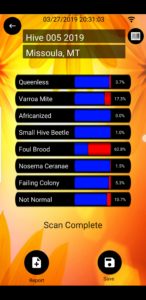How many times have beekeepers wished to communicate directly with honey bees. Impossible right now lacking a common language, that looks to be changing quickly. Technology in many realms is maturing and possibilities are literally exploding to begin the process, employing something that is all over the news lately, artificial intelligence, or simply AI.
The Wikipedia page provides some explanation: “In computer science, artificial intelligence (AI) is intelligence demonstrated by machines, in contrast to natural intelligence displayed by humans and other organisms. Computer science defines AI research as the study of ‘intelligent agents’: any device that perceives its environment and takes actions that maximize its chance of successfully achieving its goals. More specifically, Kaplan and Haenlein define AI as ‘a system’s ability to correctly interpret external data, to learn from such data, and to use those learnings to achieve specific goals and tasks through flexible adaptation.’ A quip in Tesler’s Theorem says ‘AI is whatever hasn’t been done yet.’ “
Jerry Bromenshenk and his crew at Bee Alert Technology have indeed spent the last twelve years doing something that literally “hasn’t been done yet,” decoding the songs of honey bees for improved colony health. This is not surprising given the research record of the group, resulting in employing honey bees to, among other things, monitor air and land pollution, and famously, detect plastic land mines.
The original overall vision of that research program was using honey bees to evaluate environmental impacts as part of an ecological risk assessment. It primarily involved developing and testing computerized data acquisition equipment to provide continuous, accurate, and precise field and laboratory measurements. It also included development of computer models that simulate the responses of honey bee colonies to environmental stressors. These research efforts continue to mature as Dr. Bromenshenk searches for the culmination of a vision expressed some time ago, “finding the beekeeping equivalent of putting an air-conditioned cab with yield mapping on a grain combine.” The most recent project of Bee Alert Technology, the smartphone application known as Bee Health Guru, continues the pursuit of, and threatens to exceed that goal, in ways never before imagined.
Bee Health Guru combines observations in the field using a phone’s microphone and an App running artificial intelligence software. It begins with an analysis of a sound recording, immediately and automatically performed by the program, and assigning the probability that one of eight colony health conditions is determined. It tells the user to visually inspect the colony to confirm its condition, and then save an inspection report. These three actions: (1) Recording colony sounds, (2) predicting the likelihood of specific diseases, and (3) reporting the outcome of colony inspection, provide data needed to fine-tune the AI program and map occurrences of different colony problems.
The visual inspection reports eventually should be replaced by AI analysis reports alone as the software’s accuracy improves. In essence, the program actively learns and then can be tweaked over time to ensure continuous reliability. To enact the resultant health trend mapping, beekeepers with smartphones, Android or iPhone, are needed to do the inspections and post reports. It is hoped that every user also records colony sounds so that recordings and AI analysis results are captured. However, just colony inspection reports alone can be used to generate bee health maps, revolutionizing bee health protection via early alerts. here’s an example of what a screen will look like using the beehealthguru application:
As part of this effort, Bee Alert Technology is implementing a crowdfunding initiative via Kickstarter.com to begin around May 1 and run for thirty days. The Apis Information Resource Center is pledging $75 to get this fully funded. It is hoped that every beekeeper in the world with a smartphone will support this launch. To take advantage of this, a team is needed, ready and willing to process the initial data, re-train the AI software, and enact regional bee health mapping – for the US, Canada, Europe, New Zealand, and Australia – any English speaking nation. Finally, there will be a need to produce versions of the application in other languages so as to truly go global.
As a heads up, this application is quite advanced and may not work on all operating systems now in place for smart phones. This is something that the designers are going to learn via feedback at https://www.beehealth.guru/forum/bee-health-guru-app
Originally brought to you courtesy of American Bee Journal, the beekeeper’s companion since 1861. (May 2019) “Bringing you the latest in practical bee management and bee research.”
The Kickstarter Project is now complete, but the research initiative continues as a citizen science “tuning” project with a different set of incentives.


